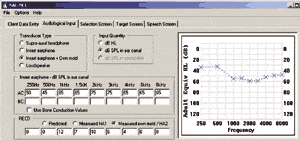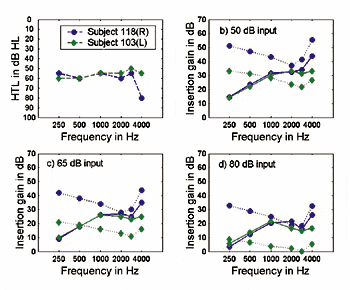|
About this year’s survey…
In March 2004, The Hearing Review (HR) mailed a 3-page questionnaire to 750 dispensing professionals whose names were chosen at random from the HR mailing list. Dispensing audiologists (DA), hearing instrument specialists (HIS), and medical doctors were included. A total of 19% of the questionnaires were completed and returned to HR (HIS 50%, DA 49%, 1% MDs). Returned questionnaires were received from every state except Rhode Island, Delaware, and Tennessee; 93% of the respondents stated that they had controlling interests in the practices/businesses, with 82% being owners and 11% being co-owners (7% of respondents were employees of the practice/business). |
Dispensing professionals view 2005 more optimistically than they have previous years: they predict better times ahead with higher unit volumes, increased net revenues, and greater profits. This year’s HR Dispenser Survey also indicates that the percentage of first-time users of hearing instruments increased for the second consecutive year (this time, from 43% to 49%), the trend toward using fewer brands of hearing aids in dispensing continues, and hearing instrument prices went down for most types of hearing aids—4.3% for digital signal processing (DSP) devices.
These are only a few of the interesting findings from the 2005 HR Dispenser Survey which is designed to gauge dispensing activity during 2004 and identify new and emerging trends in the hearing industry. Slightly more than 750 surveys were sent to dispensing audiologists (DA) hearing instrument specialists (HIS), and medical doctors (MD) who indicated on HR circulation cards that they dispensed hearing instruments. The mailing was weighted using state-by-state dispensing activity reported by the Hearing Industries Assn (HIA)1 and dispensing activity by profession as estimated by HR’s mailing list and database, as well as by MarkeTrak.2 About one-fifth (19.1%) of the questionnaires were completed and returned (Figure 1), representing 143 hearing care offices and practices in 47 states (there were 12 surveys that were returned but not tabulated for various reasons)—almost exactly the same return figures as last year’s survey.
Survey Respondents and the Average Dispensing Business
Respondents to the 2005 HR Survey were similar to respondents of last year’s survey3 in many respects, but differed in some areas that should be noted by the reader.
|
Figure 2. Profile of dispensing professionals |
||||||
|
As shown in Figure 2, the 143 returned office surveys were evenly split between hearing instrument specialists (50%) and dispensing audiologists (49%), whereas last year’s survey was more weighted toward audiologists (DA 60%; HIS 40%). Additionally, two surveys (1%) this year’ were returned by MDs. HR estimates that dispensing audiologists own 60% of the hearing aid dispensing offices and possess a slightly smaller share of the market than this figure. Sergei Kochkin’s MarkeTrak VI2 indicates that 65% of consumers in 2000 perceived their hearing instruments source to be audiologists, compared to 54% in 1997. However, MarkeTrak VII, which will appear in next month’s HR, indicates that this number could be migrating back toward hearing instrument specialists (as well as being influenced by Veteran’s Administration and Internet sales). The Hearing Journal’s annual survey,4 which has been conducted via email/Internet since 2003, had 71% of its responses from audiologists versus 26% from traditional dispensers. Whatever the actual “mix” of dispensing professionals, it would appear that this year’s HR Dispenser Survey (ie, regarding “total responses”) slightly over-represents the influence of dispensing offices owned by hearing instrument specialists.
The average DA respondent to this year’s survey is a female (51%) practice owner or partner (95%), between the ages 51-60 (42%), with a master’s degree (47%), who also holds a state license and her CCC-A, and has been dispensing hearing aids for 21 years. The average HIS respondent to this year’s survey is a male (81%) office owner or partner (92%), between ages 41-50 (44%), who attended some college (40%), holds BC-HIS certification (52%) and has been dispensing hearing aids for 21 years.
Relative to previous surveys, the major difference relative to the demographics of respondents this year, was education level, particularly regarding HIS office owners. Fewer HIS respondents reported having college degrees (22% , although it should be pointed out that 17% held advanced degrees), and far fewer were board certified in hearing instrument sciences (BC-HIS, 52% versus 64% in last year’s survey). Dispensing audiologists responding to this year’s survey were twice as likely than in the previous year to hold a PhD (24% versus 11%), while 29% held an AuD degree which is about the same (30%) as last year’s survey. Dispensing audiologists were also less likely to hold CCC-A (73% versus 80%) and ABA (19% vs 28%) certifications.
As with last year’s survey, there were two large HIS offices included in this survey that dispensed about 250 units per month plus a third that dispensed almost 175 units per month; also like last year, there was one audiology practice that dispensed more than 100 units per month. Editor’s note: These larger offices do not affect survey numbers significantly in most cases; however, they fact should be kept in mind when looking at the averages for owners’ compensation (Figure 10) and for total hearing aid units dispensed (Figure 13). In these cases, HR has provided both the average and median figures for readers.
Like previous years, respondents were overwhelmingly owners or partners of the office/practice (93%, HIS 92%; DA 95%), although slightly more employees (7%, HIS 8%; DA 5%) responded this year. Similar numbers (88%, HIS 88%; DA 89%) held state licensure, and dispensing experience was about the same as in previous years (20.2 years, HIS 19.8 years; DA 20.7 years).
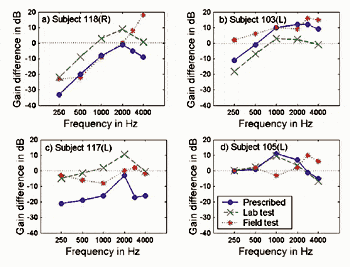
Part-time vs full-time offices. This year’s survey included a revised question that separated full-time and part-time offices (Figure 3). The results were revealing. In total, 70% of all dispensing professionals reported operating only one full time office (HIS 69%; DA 71%), 19% operated two full-time offices (HIS 14%; DA 25%), and 11% operated three or more full-time offices (HIS 17%; DA 4%).
About an equal percentage of HIS and DAs (45% total) reported operating part-time offices. Forty-five percent of HIS-owned businesses reported having part-time offices, with 23% having one part-time office, 3% having two part-time offices, 10% having three part-time offices, and 9% having four or more part-time offices. Forty-four percent of DA-owned businesses reported having part-time offices, with 30% having only one part-time office, 5% each having two or three part-time office, and 6% having 4 or more part-time offices.
The survey results suggest that, on average, the vast majority (96%) of DA dispensing businesses are constituted by one or two full-time offices, and two-fifths (40%) of those businesses also maintain three or fewer satellite offices. In contrast, four-fifths (83%) of HIS-owned businesses are constituted of one or two full-time offices, and about than one-third (36%) of HIS-owned businesses maintain three or fewer satellite offices. In general, it would appear that hearing instrument specialists are more likely to run businesses having larger numbers of offices, and this is supported by previous surveys.
Most offices/practices were situated in a private practice setting (65%, HIS 55%, DA 73%) or a retail setting such as a mall, shopping center (27%, HIS 38%, DA 16%). A small number were located in medical settings like a clinic or a hospital (6%, HIS 5%, DA 8%) or physician’s office (2%, HIS 2%, DA 3%).
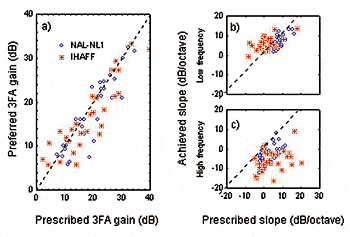
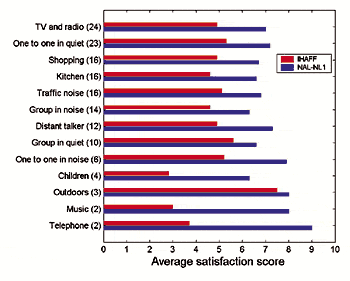
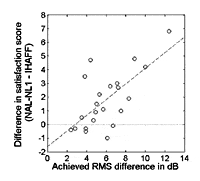
Offices affiliated with a traditional manufacturer dispensing network (Beltone, Miracle Ear, etc) accounted for 11% of all survey responses (HIS 15%, DA 8%), but only 1% of offices (HIS 2%, DA 0%) were actually owned by manufacturers. Likewise, 7% of the offices (HIS 7%; DA 8%) in the survey reported being affiliated with, but not owned by, national corporate retail networks (ie, Sonus, HearUSA, etc)—down 8 percentage points from the 2004 HR Survey. As with the traditional manufacturer networks, national corporate retail networks were reported to own just 2% of the responding offices (HIS 2%; DA 2%).
Market statistics appear to indicate that traditional manufacturer and corporate retail networks constitute about one-fifth of the US hearing instrument dispensing activity.
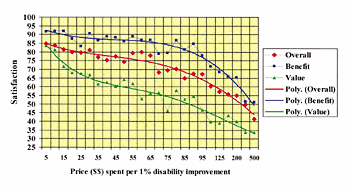
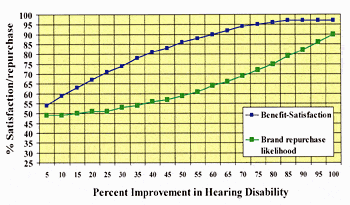
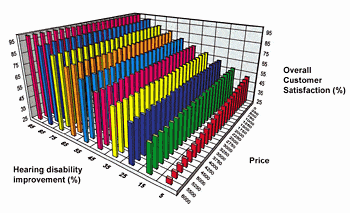
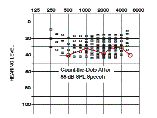
The method of reimbursement for employees was markedly different between office types, as well. An equal percentage of HIS-owned and DA-owned offices reported using “fixed salaries” for compensation (55%, HIS 56%, DA 55%). However, the DA-owned offices relied almost exclusively on “salary-plus-commission” as the second most-frequently-used system of compensation (36%, HIS 31%; DA 42%) while HIS-owned offices relied heavily on both salary-plus-commission and “commission only” compensation systems (15%, HIS 25%; DA 4%). Only 3% of all offices (HIS 2%; DA 4%) used a system of “commission plus expenses.” Due to an increased focus on ethics from all professional organizations, methods of compensation have come under increased scrutiny, with most advocating for the use of fixed salaries in an effort to eliminate any real or perceived conflict of interest relative to dispensing products to patients/clients.
Owners of the dispensing practices had mean declared salaries of $80,000, a 6% increase over 2003 (HIS $75,000, DA $92,500). The average salary of a dispensing office owner was $96,301 (HIS 86,805; DA $105,571), a 4% increase.
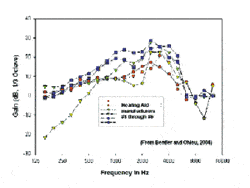

There were two separate questions concerning the number of units dispensed by survey respondents (Figures 12-13). Figure 12 shows the responses to the question, “Average number of units dispensed per month in 2004.” For all dispensing professionals, the average response was 29 units per month (HIS 32; DA 24), and it can be seen that the distribution is relatively evenly divided from dispensing levels of 5-10 units per month up to 21-30 units per month (71% of all responses, HIS 74%, DA 68%). Far fewer offices dispense more than 30 hearing aids per month (24%, HIS 21%, DA 27%).
As mentioned earlier, there were three large HIS offices that dispensed 175-250 units per month (ie, similar to the two large HIS-owned offices included in last year’s survey). Deleting these large practices would produce an average of 24.4 units dispensed per month (HIS 23.3 units), but would not affect the median stated in Figure 12.

Figure 13 reflects the answers to the question, “What were the total net number of hearing instruments dispensed in your practice/business during 2003 and 2004?” Responses revealed that an average of 349 hearing instruments (HIS 398 units, DA 292 units) were dispensed by all offices in 2004, compared to 307 hearing aids in 2003 (HIS 348 units; DA 259 units)—a 13.7% increase. This would yield 29.1 units per month for all offices (HIS 33.2 units, DA 24.3 units) in 2004 versus 25.6 units per month in 2003 (HIS 29.0 units, DA 21.6 units).
Again, if you take out the three large HIS offices mentioned above, the average for all offices in Figure 13 would decline to 282 units in 2004 (HIS 273 units, DA 292 units) and 252 units in 2003 (HIS 246 units, DA 259 units), or an 11.9% increase. Relative to units dispensed per month, this would yield 20.5 units for HIS-owned offices and 21.6 units for DA-owned offices.
It is clear that these large offices have a significant impact on the above statistics; however, since larger practices keep reappearing in the HR Survey on a yearly basis, ignoring their overall impact (or relying on median values) on the market may not be wise. In comparing the differences between the answers in Figures 12 and 13, it would appear that when a dispensing professional is asked about the number of hearing aids their office dispenses, a monthly dispensing estimate may not always accurately reflect the total number of units dispensed during that year.
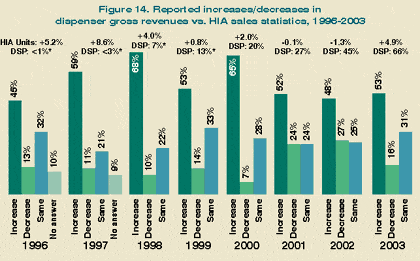
MarkeTrak2 statistics on binaural fitting rates closely follow HR Dispenser Survey statistics (Figure 15), with all users who had purchased within the survey period having binaural fittings 65.3% of the time in 1994, 65.2% in 1997, and 74.2% in 2000.2

This difference between professions may be explained by uneven utilization rates in directional microphone systems (discussed below) and, quite possibly, the increasing popularity of open-ear systems. Additional factors leading to increased use of BTEs could include new systems (ie, Sebotek PAC, Vivatone), smaller and more transparent tubing options, greater capacity for processing, FM systems, and a range of new BTE options that often utilize telecoils.5,6 Additionally, the rapidly growing area of Bluetooth, WiFi, and other wireless technologies pouring into the amplification arena (ie, see the HR Tech Topics of the January and April 2005 issues) may help continue this trend for some time to come—and may someday succeed in transforming ear-worn amplification devices into “cool” trendy items.7
Survey respondents reported that they used ITEs for 31% of their fittings (HIS 32%; DA 29%), ITCs for 26% of their fittings (HIS 28%; DA 24%), and CICs for 18% of their fittings (HIS 22%; DA 14%). The only style to go down by 5 percentage points or more in the last 5 years (ie, since 1999) was dispensing audiologists’ use of CICs. Again, this may be explained by the greater utilization of special features in BTEs (as discussed below).
HIA statistics1 indicate that 26.4% of all hearing instruments dispensed in 2004 were BTEs, up from 23.7% in 2003, and 22.8% in 2002. ITEs made up 39.4% of the market, ITCs 19.9%, and CICs 14.3%, according to HIA 2004 year-end data.
In most years, the HR Dispenser Survey has proven to be an excellent gauge in anticipating trends in hearing instruments use patterns (ie, see the new HIA report on BTE use on p 10 of this issue). The overall trends, as shown in Figure 17, suggests that BTEs could soon be rivaling ITEs in terms of market share.

HIA statistics1 indicate that DSP hearing instruments made up 83.0% of the market in 2004, compared to 65.8% in 2003, and 44.6% in 2002. The same figures indicate that non-programmable analog and programmable analog technology constituted 12.1% and 4.9% of the market respectively. In the first quarter of 2005, HIA reports that DSP instruments accounted for 87.9% of the market.8

Similarly, the percentage of hearing aids that are sold from an office/practice’s most-popular brand has been edging upward during the last 6 years (Figures 22-23). In 2004, the average office used one brand in 75% of its sales (HIS 80%; DA 70%). By comparison, five years earlier in 1999, the average office used one brand in 68% of its sales (HIS 75%; DA 61%).

Directional systems. During the last 3 years, DA-owned offices have been almost completely responsible for the surge in use of directional hearing systems (Figure 24). From 2001-2002, directional microphone use among dispensing audiologists went from 29% to 44%, and utilization has hovered at 47-48% during 2003-2004. In contrast, hearing instrument specialists have been fairly resistant to increasing their use of directional hearing systems until 2004, with a static 17% utilization rate from 2001-2003. However, in 2004, HIS-owned offices reported that they prescribe directional systems for 24% in their hearing instruments.

In total, the utilization of directional microphone systems in 2004 stayed the same (36%) as 2003. HR expects this number to continue to move toward the 45% mark, a figure that would encompass virtually all hearing instrument styles except for the smallest aids (ie, ITCs, CICs) that prohibit the installment of directional microphones on a faceplate.
Other hearing instrument options. This year, HR also asked dispensing professionals about their use of volume controls (VC), telecoils, remote controls, and FM boots on BTEs (Figure 25). HIS-owned offices prescribe volume controls for nearly three in four (73%) of their clients. In contrast, DA-owned offices prescribe VCs for only two in five (40%) of the patients that they fit. In total, it appears that 57% of the aids fit feature a VC.
MarkeTrak9 suggests that 75% of ITE hearing aids in 2000-2001 contained VCs. Kochkin has also shown that, although the movement toward automatic gain control hearing aids is a positive trend—one that will ultimately make hearing aid use more satisfying to the consumer—the removal of VCs has almost certainly led to frustration among consumers because of the basic human desire for having control in any situation.9 Surr et al10 found that 77% of consumers still desired a VC even though these people rarely used them.
Telecoils were reported to be used in 39% of all the hearing instruments dispensed in 2004 (HIS 35%; DA 43%), about the same as in 2002 (37%, HIS 30%; DA 44%). As reported by Myers,6 a 1999 ADA Advisory Committee reported that only 30% of modern hearing aids contain a telecoil. Myers also reported on a survey of the “Big 6” hearing instrument manufacturers which led to the investigators’ conclusion that 48% of the hearing aids sold in the US contained telecoils (R Blaha & S Davidson, Hearing Aid Telecoils: Current Numbers in the US Market, AAA 2004 Convention, Philadelphia). With the number of new applications for telecoils and sales of BTEs rising swiftly, HR predicts that telecoil use will continue to increase toward a 50-60% utilization rate.
Remote controls were reported by survey respondents to be used in only 2% of their fittings (HIS 1%, DA 3%), and FM boots were used in only 7% of their BTE fittings (HIS 7%, DA 6%).
Hearing Aid Pricing
Similar to last year’s HR Dispenser Survey, respondents were asked to fill in their 2004 pricing for premium DSP, economy DSP, programmable analog, and analog linear aids relative to each style of hearing aid (BTE, ITE, ITC, and CIC). This yielded 16 different price categories, and mid-level DSP prices were estimated as the resulting mid-point between the premium and economy DSP categories (Figure 26).

What emerges is that, overall hearing instrument prices decreased in most, but not all, of the categories. This year’s survey suggests that overall premium DSP prices in 2004 ranged from $2,509-$2,842 compared to $2,559-$3,041 in 2003. Mid-level DSP prices ranged from $1,960-$2,292 compared to $1,974-$2,374 in 2003. Economy DSP instrument prices in 2004 ranged from $1,409-$1,742 compared to $1,390-$1,708 in 2003. Prices in 2004 for programmable analog instruments ranged from $1,164-$1,440 compared to $1,244-$1,536 in 2003, and analog linear aids ranged in price from $896-1,242 compared to $916-$1,339 for the previous year. Additionally, the prices of hearing instruments between the professions appear to have drawn closer than in previous years.
In the premium DSP category, overall prices declined in a fairly uniform manner by $50-$100 (HIS -$126 to -$234; DA -$17 to -$166). However, in the economy DSP category, overall prices remained fairly static, departing from last years prices by no more than $38. The prices of most analog programmable and linear aids continued to decrease in both HIS-owned and DA-owned offices. Overall prices of these aids fell by $32-$120, except for analog linear ITEs.
When looking at the 2004 prices from a percentage increase/decrease standpoint, all dispensing professionals saw their premium DSP prices decrease by -2% to -6% in 2004 compared to 2003 (HIS range of -5% to -8%; DA range of -1% to -5%). However, price changes for economy DSP devices were more of a mixed bag: all styles of economy DSP aids declined substantially in price for offices owned by hearing instrument specialists (with a range of -8% to -12%), while all the prices for these same aids increased for offices owned by dispensing audiologists (with a range of 5%-10%).

In general, when speaking with manufacturers, their responses to this question usually range from 15%-20% for premium lines, but they provide more variable answers for the non-premium categories: 40%-65% for mid-level DSP lines, and 20%-35% for economy lines.

When considering all hearing care professionals and all technologies and styles of hearing aids, the weighted average price of a hearing aid in 2004 was $1,893—a 5% ($99) increase over the average 2003 price of $1,794. However, it should be kept in mind that the average price did not rise because of higher prices charged by dispensing professionals; rather, the price increase is due to the far greater numbers of consumers choosing DSP products over the more traditional analog technologies (ie, digital hearing instrument market share increased from 66% in 2003 to 83% in 2004).
Figure 29 shows an 8-year history of weighted average prices for linear, programmable, and DSP hearing instruments. Two things should be noted here: 1) the average price of DSP hearing instruments reached its peak in 2000 ($2,496, HIS $2,572; DA $2,496) and has since declined steadily by $430 over the ensuing 4 years; 2) the average prices for analog linear and analog programmable technologies have migrated toward each other. In 1997, the average prices of these technologies were separated by about $700, whereas today they are separated by only $254. This is almost certainly due to the advent of economy digital hearing instruments, devices that are now essentially defining the upper price limits where analog technology can be marketed. It is altogether possible, if not probable, that next year’s survey will be the last in which we address programmable analog market parameters. Indeed, HIA1 stopped tracking this class of hearing instruments in 2005, instead integrating them into one “analog” category.

Additionally, the HR Dispenser Survey’s reported prices, in general, do not take into account free, discounted, or third-party payer hearing aids. Figure 31 shows that about one-third (35%, HIS 31%; DA 39%) of all dispensing offices maintain contracts for services with managed care organizations (MCOs) and/or healthcare maintenance organizations (HMOs). Those dispensing offices that do maintain contracts have about one-in-five of their clients/patients covered by the insurance (22%, HIS 21%; DA 23%), and those clients account for 19% of their gross revenues (HIS 17%; DA 20%).
As a reference, MarkeTrak2 indicates that, in 2000, consumers paid $1,197 for a BTE, $1,295 for an ITC, and $1,009 for an ITC.

Hearing Aid Testing, Fitting, and Associated Services
Figure 32 shows that more than half of all hearing care offices that dispensed hearing instruments in 2004 contained an audiometer (98%, HIS 97%; DA 100%), a sound booth (80%, HIS 65%; DA 97%), and a video otoscope (66%, HIS 81%; DA 52%). Additionally, most offices had impedance testing equipment (61%, HIS 27%; DA 97%) and a real-ear measurement system (60%, HIS 44%; DA 77%). Master hearing aids were found in 60% of HIS offices, but in only 22% of DA offices. In contrast, OAE and ABR testing systems were found in one-half (50%) and one-quarter (25%) of DA-owned offices respectively, but in almost no HIS-owned offices (2% respectively). Virtual sound environments and environmental sound simulators were possessed by 24% of all offices (HIS 24%; DA 23%). ENG equipment for the testing of vestibular and balance disorders were found in 18% of DA offices and 2% of HIS offices, and ASSR systems were found in only 2% of all offices (HIS 2%; DA 3%).
When a patient comes to a hearing care professional for a routine hearing assessment and hearing aid fitting, the HR Dispenser Survey suggests that they will almost always (more than 85% of the time, bottom table in Figure 32) receive air and bone threshold testing, word recognition and speech reception threshold testing, and speech UCL/MCL testing. Most dispensing professionals also incorporate into their testing and fitting protocols tympanometry (57%, HIS 30%, DA 85%) and video otoscopy (51%, HIS 75%; DA 27%). About one-third of all offices incorporate tone UCL/MCL measures (39%, HIS 46%; DA 32%), acoustic reflexes (28%, HIS 2%; DA 55%), and real-ear measurement (26%, HIS 16%; DA 37%). A minority of offices use acoustic reflex decay tests (15%, HIS 3%; DA 27%) and OAEs (9%, HIS 0%; DA 18%) as part of their routine testing and fitting protocols.

As a reference, MarkeTrak2 indicates that, in 2000, consumers paid $1,197 for a BTE, $1,295 for an ITC, and $1,009 for an ITC.
Hearing Aid Testing, Fitting, and Associated Services
Figure 32 shows that more than half of all hearing care offices that dispensed hearing instruments in 2004 contained an audiometer (98%, HIS 97%; DA 100%), a sound booth (80%, HIS 65%; DA 97%), and a video otoscope (66%, HIS 81%; DA 52%). Additionally, most offices had impedance testing equipment (61%, HIS 27%; DA 97%) and a real-ear measurement system (60%, HIS 44%; DA 77%). Master hearing aids were found in 60% of HIS offices, but in only 22% of DA offices. In contrast, OAE and ABR testing systems were found in one-half (50%) and one-quarter (25%) of DA-owned offices respectively, but in almost no HIS-owned offices (2% respectively). Virtual sound environments and environmental sound simulators were possessed by 24% of all offices (HIS 24%; DA 23%). ENG equipment for the testing of vestibular and balance disorders were found in 18% of DA offices and 2% of HIS offices, and ASSR systems were found in only 2% of all offices (HIS 2%; DA 3%).
When a patient comes to a hearing care professional for a routine hearing assessment and hearing aid fitting, the HR Dispenser Survey suggests that they will almost always (more than 85% of the time, bottom table in Figure 32) receive air and bone threshold testing, word recognition and speech reception threshold testing, and speech UCL/MCL testing. Most dispensing professionals also incorporate into their testing and fitting protocols tympanometry (57%, HIS 30%, DA 85%) and video otoscopy (51%, HIS 75%; DA 27%). About one-third of all offices incorporate tone UCL/MCL measures (39%, HIS 46%; DA 32%), acoustic reflexes (28%, HIS 2%; DA 55%), and real-ear measurement (26%, HIS 16%; DA 37%). A minority of offices use acoustic reflex decay tests (15%, HIS 3%; DA 27%) and OAEs (9%, HIS 0%; DA 18%) as part of their routine testing and fitting protocols.
Speech in noise testing. In addition to the above routine tests, nearly one-half (48%, HIS 31%; DA 65%) of dispensing offices reported that they used some form of speech-in-noise testing in 2004, a decrease from 52% in 2003 (HIS 46%; DA 55%). Specific speech-in-noise testing methods and the percentage utilization of these tests are shown at the bottom of Figure 33. The survey results suggest that, of those professionals who do assess their client/patients’ speech-in-noise performance, 70% of dispensing audiologists rely on one of the standardized testing methods, while only half as many (38%) hearing instrument specialists prefer to use these tests; instead, nearly half (49%) of hearing instrument specialists prefer to use their own combinations of speech/noise presentation levels to assess their client’s performance in noise, compared to about one-fifth (22%) of dispensing audiologists. The most popular standard tests were the QuickSIN (36%, HIS 13%; DA 45%), HINT (11%, HIS 6%; DA 14%), SPIN (9%, HIS 6%; DA 9%), and SIN (5%, HIS 13%, DA 0%). “Other” tests were indicated by 9% of respondents (HIS 13%; DA 8%).



Patients/Clients of Dispensing Professionals
Overall, dispensing offices report having an average of 1,905 active patient files (HIS 1,955; DA 1,850), with a median of 1,200 active files (HIS 1,000; DA 1,500). Over three-quarters of those responding indicated that they have fewer than 3,000 active patients: approximately one-quarter of the dispensers each said they had “less than 500,” “1,001-2,000,” or “1,001-2,001” active patient files. Nine percent (HIS 7%, DA 12%) said they have 2,001-3,000 active patient files, 7% (HIS 4%; DA 10%) said they have 3,001-4,000 files, and 11% (HIS 11%; DA 12%) said they have over 4,000 active files.
Age of clients. When assessing client/patient ages, the most common age group visiting dispensing professionals is the 65-84 year old group (52%, HIS 58%; DA 48%). As with past surveys, 2004 figures showed that DA-owned offices serve a slightly younger patient demographic than HIS-owned offices. A total of 27% of the customers in a typical DA office are between ages 30-64, while 22% of a typical HIS office is made up of these patients (the age group makes up 25% of all customers seen). DA offices also have 12% of their patient base made up of people younger than age 29, compared to only 3% for HIS offices. Looking at it another way, HIS-offices tend to serve older clients: 17% of HIS customers are over age 85, while only 13% of DA customers are from this age group.


New Users. There has been a lot of hand-wringing about the statistics on first-time users of hearing instruments (Figure 38) as a percentage of yearly hearing instrument purchasers. In the 1980s, first-time user rates were often in the 60%-80% range, but these rates have fallen off to as low as 41% in 2002. As a slight ray of hope, last year’s HR Dispenser Survey did show that first-time clients in hearing care offices increased to 43% in 2003 from 41% in 2002.
Reports for 2004 bring far better and more reassuring news: as shown in Figure 39, the percentage of first-time customers reported by survey respondents rose to 49% (HIS 48%; DA 50%). Whether this is due to the decrease in hearing instrument pricing, pent-up demand, an aging population, or some other factor(s) is unclear. Whatever the reason, the 2004 first-time user rate rose by 6 percentage points and is on par with those rates experienced during the mid-to-late 1990s (Figure 38).



Multiple disabilities. Because dispensing professionals see patients who are predominantly over age 65, they often have patients who are dealing with other life challenges (ie, hearing loss and another disability). The most-common, non-hearing-related patient disabilities encountered by dispensing professionals (Figure 41) are patients who require wheelchairs and walkers (16%, HIS 14%; DA 18%), severe vision problems or blindness (10%, HIS 10%; DA 9%), severe dexterity problems including Parkinsons disease or quaking hands (9%, HIS 9%; DA 8%), cognitive disorders including Alzheimers disease (8%, HIS 8%; DA 9%), and great difficulty speaking or the inability to talk (3%, HIS 2%; DA 4%).

The outlook for 2005 by all dispensing professionals is nothing short of enthusiastic (Figure 42). Two-thirds of all dispensing professionals (67%) predicted that, in 2005, they would experience unit sales gains by an average of 14% compared to 2004. A total of 26% of offices believed they would have the same unit sales as in 2004, and only 7% predicted that their sales would decrease by an average of -12%.
Expected gross revenues and profits were very similar to the above. For example, 68% of all dispensing professionals (HIS 66%, DA 70%) predicted that their sales revenues would increase by an average of 16% in 2005, while 24% (HIS 29%; DA 19%) predicted flat revenues, and only 8% (HIS 5%; DA 11%) said they thought their sales would decrease by an average of 9%.
If they are correct, dispensing professionals will prosper in a new era of hearing aid technology full of consumer options. w
Acknowledgements
The editor thanks Christina Jackson, CPA, an accountant in Two Harbors, Minn, for her excellent work in tabulating the survey questionnaires and formatting the survey data.
Correspondence can be addressed to Karl Strom, email: [email protected].
References
1 Hearing Industries Association. Quarterly statistics report for the fourth quarter 2004. Alexandria, Va: HIA; 2005.
2. Kochkin S. MarkeTrak VI: The VA and direct mail sales spark growth in hearing aid market. The Hearing Review. 2001;8(12):16-24, 63-65.
3 Strom KE. The 2004 dispenser survey. The Hearing Review. 2004;11(6):14-32,58-59.
4. Kirkwood D. Dispensers surveyed on what leads to patient satisfaction. Hear Jour. 2005;19-26.
5. Strom KE. Reasons for optimism: A look at the 2004-2005 hearing instrument market. The Hearing Review. 2005;12(3):18-25, 78-79.
6. Myers D. Heard around the world! Hearing aid compatibility and wireless assistive devices. The Hearing Review. 2005;12(1):22-25, 86.
7. Strom KE. Satellite assisted hearing aids? The Hearing Review. 2005;12(5):6.
8. Hearing Industries Association. Quarterly statistics report for the first quarter 2005 Alexandria, Va: HIA; 2005.
9. Kochkin S. Isolating the impact of the volume control on customer satisfaction. Hearing Review. 2003;10(1):26-35.
10. Surr RK, Cord MT, Walden BE. Response of hearing aid wearers to the absence of a user-operated volume control. Hear Jour. 2001; 54(4):332-36.
11. Yntema S. Americans 55 & Older, A Changing Market. New York: New Strategist Publications; 1999.

